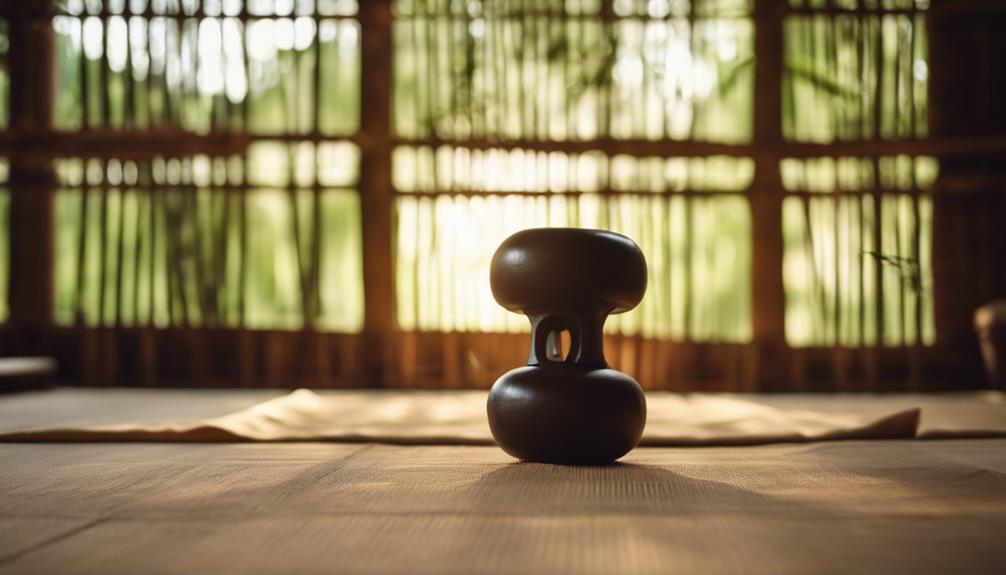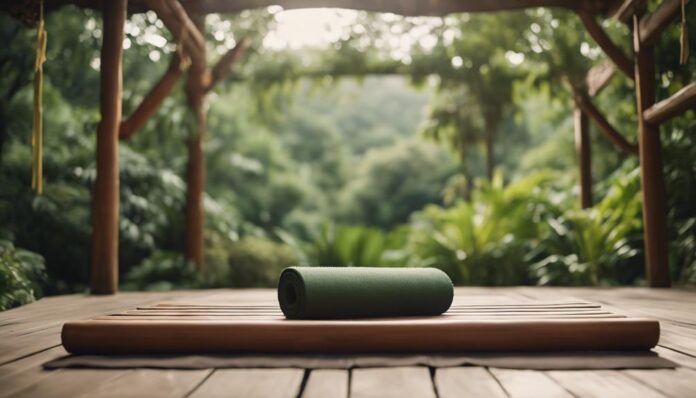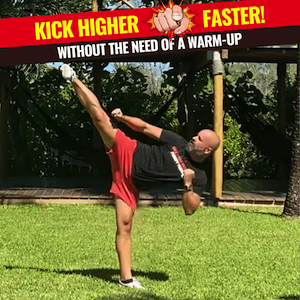As a martial artist over 40, you must prioritize flexibility training to maintain peak performance and prevent age-related declines in mobility and technique. You'll need to incorporate dynamic stretching techniques, such as leg swings and arm circles, to prepare your muscles for martial arts movements. Targeted stretches, like hamstring and hip flexor stretches, will also help improve your kick height and stability. By making flexibility training a consistent part of your routine, you'll see significant improvements in your technique and overall performance. With the right approach, you can adapt your training to meet the unique demands of martial arts over 40.
Flexibility Exercises for Martial Arts
Flexibility is a vital component of martial arts performance, and as you age, its importance only intensifies. To maintain or improve your flexibility, you'll need to incorporate targeted exercises into your training routine.
Dynamic stretching, such as leg swings and controlled movements, is essential for enhancing blood flow and range of motion. Focus on specific stretches like hamstring, hip flexor, and quadriceps stretches to improve your kick height and stability during techniques.
You should also practice the wide horse stance exercise to build hip flexibility and strength, important for executing high kicks effectively.
Resistance band training can also help improve strength and flexibility simultaneously, taking your martial arts performance to the next level.
To see significant improvements in flexibility, consistency is key. Make daily stretching routines a priority, incorporating practices like PNF (Proprioceptive Neuromuscular Facilitation) stretching to enhance your flexibility over time.
By incorporating these exercises into your routine, you'll be able to maintain or improve your flexibility, even as you age, allowing you to continue performing at your best in martial arts.
Regular stretching will also help prevent injuries and improve overall performance.
Training Regimens for Reduced Flexibility
As you address reduced flexibility in your martial arts training over 40, you'll need to adapt your stretching techniques to accommodate your changing physical needs.
This may involve incorporating low-impact training options, such as resistance band exercises or modified dynamic stretches, to minimize the risk of injury while maintaining flexibility.
Adapting Stretching Techniques
The age-related decline in flexibility necessitates modifications to traditional stretching techniques. As you adapt your stretching routine to accommodate reduced flexibility, you'll want to focus on methods that effectively enhance range of motion and kick height.
- Incorporate dynamic stretching, which involves moving your joints through a range of motion while keeping your muscles active.
- Utilize PNF techniques, a set of stretching methods that increase flexibility by stimulating nerve endings and contracting and relaxing specific muscle groups.
- Engage in targeted stretching exercises, such as hip flexor and hamstring stretches, to improve flexibility in areas vital to martial arts performance.
Consistently practicing these stretches will lead to significant improvements in flexibility over time. Additionally, incorporating resistance band training won't only improve strength but also support flexibility development, making it an essential component of your age-appropriate stretching regimen.
Low-Impact Training Options
Modifying your martial arts training to accommodate reduced flexibility is vital to maintaining performance and preventing injury over 40. You can achieve this by incorporating low-impact training options into your regimen. Disciplines like Aikido and Kempo Karate focus on technique and form, making them ideal for individuals with reduced flexibility.
These low-impact martial arts allow you to progress gradually, accommodating slower recovery times and promoting safe skill development.
To enhance flexibility while minimizing stress on your body, incorporate joint mobility exercises into your low-impact training. This is essential for older practitioners, as it helps maintain mobility and prevent injuries.
You can also practice Jiu Jitsu and Judo with low resistance, improving mobility and flexibility without the risk of high-impact injuries. Regular engagement in low-impact training not only improves flexibility but also supports overall physical fitness and mental discipline.
Effective Stretching Techniques Over 40
As you adapt your stretching routine to accommodate the physical changes that come with aging, you'll need to make age-related adjustments to maintain flexibility and range of motion.
To do this effectively, it's crucial to avoid common stretching mistakes, such as neglecting proper warm-ups, overstretching, or bouncing during stretches.
Age-Related Stretching Adjustments
Because flexibility naturally declines with age, incorporating age-related stretching adjustments into your martial arts training becomes vital after 40.
As you age, your flexibility may decrease, making it important to adapt your stretching routine to maintain and improve range of motion for peak performance. Proprioceptive Neuromuscular Facilitation (PNF) stretching, which involves contracting and relaxing muscles, is particularly effective for older practitioners when performed with a partner.
To enhance your stretching routine, consider the following adjustments:
- Gradually increase stretch intensity to avoid injury and promote progressive improvement in flexibility.
- Incorporate dynamic stretching techniques, such as leg swings and arm circles, to enhance range of motion and prepare muscles for martial arts movements.
- Integrate yoga into your flexibility training to enhance alignment and recovery, providing additional benefits for overall flexibility and performance.
Avoiding Common Stretching Mistakes
In the pursuit of enhanced flexibility, you must be mindful of common stretching mistakes that can hinder your progress and increase the risk of injury, particularly after the age of 40. One critical error to avoid is forceful stretching, which can lead to ligament damage and injuries. Instead, incorporate dynamic stretching and PNF techniques to improve flexibility. Relying solely on static stretches may not yield the desired results.
Neglecting muscle relaxation during stretching routines is another common mistake. Focus on breathing and gentle movements to enhance relaxation, allowing your muscles to lengthen and adapt.
Additionally, underestimating the time required for gradual flexibility improvement can lead to frustration. Commit to consistent daily practice, even if it's just a few minutes a day, to achieve noticeable progress.
Incorporating resistance band training can also enhance both strength and flexibility, providing a balanced approach to your stretching routines.
Effective Stretching Techniques
Certain stretching techniques prove more effective than others for martial artists over 40.
You'll want to focus on methods that enhance flexibility, range of motion, and strength, while minimizing the risk of injury.
- *Dynamic stretching* is essential for warming up before martial arts practice, as it enhances blood flow and range of motion. Leg swings and controlled movements are great examples of dynamic stretches.
- *PNF stretching*, which involves contracting and relaxing muscles, can be particularly effective when done with a partner to achieve deeper stretches. This technique can help improve flexibility and range of motion in areas critical for martial arts, such as the hips and hamstrings.
- *Resistance bands* can be used during stretching routines to enhance both strength and flexibility, making them an effective method for maintaining martial arts performance over 40.
Incorporate these techniques into your stretching routine to improve your flexibility and range of motion.
Remember to avoid forceful stretching and listen to your body, as older adults may need longer recovery times and should prioritize gradual flexibility improvement to prevent injuries.
Improving Kick Height With Flexibility
As you focus on enhancing your martial arts skills, improving kick height is an essential aspect that relies heavily on flexibility. To deliver powerful and precise kicks, you need to increase your range of motion in the hips and legs. Regular hip stretching exercises, such as side rising kicks and wide horse stance, can greatly increase flexibility and contribute to higher kicks.
Engaging in dynamic stretching and PNF techniques before training has been shown to be more effective for improving kick height than static stretching alone. You can incorporate these exercises into your warm-up routine to enhance your kicking performance.
Age-related changes may lead to decreased flexibility, but consistent practice of targeted stretching exercises can still yield considerable improvements in kick height for individuals over 40. Additionally, maintaining a healthy weight through a balanced diet and regular exercise can also positively impact kicking performance, as excess weight can limit both flexibility and overall kicking ability.
Incorporating Yoga for Enhanced Flexibility

You can enhance your martial arts flexibility over 40 by incorporating yoga into your routine, which improves alignment, proprioception, and overall flexibility.
As you integrate yoga into your training, you'll target key muscle groups used in martial arts, aiding in increased range of motion and improved kicking technique.
Benefits of Yoga Integration
Numerous martial artists over 40 are turning to yoga to enhance their flexibility and take their training to the next level.
By incorporating yoga into your martial arts training, you'll experience significant benefits that will enhance your overall performance.
You'll notice improvements in alignment and proprioception, allowing you to execute techniques with precision and control. Regular yoga practice will also enhance your flexibility, particularly in the hips and lower back, enabling you to deliver higher and more effective kicks.
Some key benefits of yoga integration include:
- Improved flexibility and range of motion, targeting specific muscle groups used in martial arts
- Enhanced muscle relaxation and recovery, reducing the risk of injury and accelerating recovery time
- Increased mental discipline and focus, thanks to the emphasis on breath control and mindfulness in yoga
Effective Yoga Techniques Explained
Regularly incorporating yoga into your martial arts training can greatly enhance flexibility, improve range of motion, and aid in recovery from injuries, making it especially beneficial for practitioners over 40.
By targeting specific areas, such as the hips, you can enhance kicking techniques and overall performance. The pigeon pose and downward-facing dog are particularly effective for improving hip flexibility, allowing for better alignment and muscle relaxation.
As you incorporate yoga into your training, you'll also notice improvements in mental focus and body awareness.
These benefits are essential for executing martial arts techniques effectively, allowing you to anticipate and react to situations more efficiently.
Yoga techniques like deep breathing and relaxation can also help manage stress and improve overall well-being, further contributing to your training longevity.
Avoiding Yoga Injury Risks
Building flexibility through yoga requires a deliberate approach, particularly for martial artists over 40. As you age, your body's capabilities change, and injury risk increases.
To avoid yoga injury risks, focus on alignment and proper technique when practicing poses. This attention to detail helps prevent injuries and guarantees you're targeting the right muscles for flexibility gains.
In addition to proper technique, incorporate the following strategies into your yoga routine:
- Utilize props like blocks and straps to achieve deeper stretches safely and comfortably, reducing the risk of overexertion.
- Listen to your body and respect its limits; pushing too hard can lead to ligament damage or chronic injuries.
- Gradually progress through yoga routines, allowing for consistent practice and sustainable flexibility improvements while minimizing injury risk.
Nutrition and Self-Care for Flexibility
A well-planned diet and self-care routine are fundamental for martial artists over 40 looking to improve their flexibility. Proper nutrition plays a significant role in supporting muscle recovery and enhancing flexibility.
Focus on consuming whole foods like vegetables and lean proteins, which provide the necessary building blocks for muscle repair and growth. Additionally, hydration is essential for maintaining muscle elasticity, so drink adequate water throughout the day to aid in flexibility training.
Incorporate anti-inflammatory foods, such as fatty fish and nuts, to help reduce muscle soreness and improve recovery times. Avoid processed foods, sugars, and excessive alcohol, which can hinder flexibility and overall performance.
Regular self-care practices, including adequate sleep and stress management techniques like meditation, can also greatly enhance flexibility by promoting muscle relaxation and recovery.
Prioritize muscle recovery by getting enough sleep and engaging in activities that help manage stress. By combining a balanced diet with a consistent self-care routine, you'll be better equipped to improve your flexibility and maintain peak performance in your martial arts training.
Low-Impact Training for Injury Prevention

Nearly all martial arts practitioners over 40 can benefit from incorporating low-impact training into their routine, as it greatly reduces the risk of injury while improving flexibility and mobility.
As you age, your recovery times lengthen, making you more prone to overexertion and injuries. Low-impact training methods, such as Aikido and Kempo Karate, emphasize technique over force, allowing you to enhance your flexibility and mobility while minimizing the risk of injury.
To get the most out of low-impact training, keep the following in mind:
- Gradually increase intensity and incorporate modifications in your training to prevent overexertion and injuries.
- Engage in low-resistance practices like Jiu Jitsu and Judo to develop your skills while minimizing strain on your joints and muscles.
- Focus on proper warm-ups and dynamic stretching to prepare your body for low-impact training, increasing blood flow and flexibility while lowering the risk of injury.
Dynamic Stretching for Martial Arts
Kick-start your martial arts training with dynamic stretching, a warm-up technique that can help you overcome the physical limitations that come with aging. As you age, your flexibility and range of motion may decrease, affecting your performance in martial arts.
Dynamic stretching can help counteract these effects by increasing blood flow and range of motion. This technique involves controlled movements that prepare your muscles and joints for the demands of martial arts practice.
Incorporate dynamic stretches like leg swings, arm circles, and torso twists into your warm-up routine. These exercises improve hip and shoulder flexibility, essential for executing high kicks and powerful strikes.
Spend 5-10 minutes on dynamic stretching before training to reap its benefits. Research shows that dynamic stretching is more beneficial for enhancing athletic performance than static stretching.
Flexibility and Technique Over 40

As you integrate dynamic stretching into your warm-up routine, you'll notice improvements in your flexibility and range of motion. However, it's equally important to focus on the interplay between flexibility and technique in your martial arts training over 40.
To optimize your performance, you need to understand how flexibility affects your technique. Regular flexibility training greatly reduces the risk of injuries, especially in older practitioners with stiffer joints and muscles.
To enhance your technique, focus on:
- Practicing targeted stretches, such as hip flexor and hamstring stretches, to improve kick height and execution.
- Incorporating age-appropriate flexibility routines that combine strength and flexibility training to prevent injuries while achieving higher flexibility.
- Understanding the mechanics of each kick to optimize performance and technique.
Maintaining Flexibility With Age
Facing the challenges of aging, you must prioritize flexibility training to maintain range of motion and optimize martial arts performance. As you age, your flexibility naturally decreases due to reduced physical activity and muscle elasticity, making regular training essential. Consistent effort in flexibility routines can counteract age-related declines, allowing you to improve your kicking height and overall performance.
To maintain flexibility with age, it's vital to tailor your training program to accommodate age-specific physical changes. You may require longer recovery times and adjusted stretching techniques. Incorporating dynamic stretching and PNF techniques can be more effective than static stretches for improving flexibility, particularly over 40.
A well-rounded flexibility training program, including yoga and targeted stretches, can enhance both flexibility and overall physical health, promoting longevity in martial arts practice. By prioritizing age-specific flexibility training, you can optimize your performance and continue to excel in martial arts despite the challenges of aging.
In Summary
As you push past 40, your martial arts practice demands adaptability, not excuses. By incorporating flexibility exercises, training regimens, and low-impact techniques, you'll shatter the stereotype that age means decline. Like a willow tree that bends but never breaks, your body will become resilient and pliable, defying the odds. With persistence and the right approach, you'll kick higher, stretch further, and prove that flexibility is not a function of age, but of dedication.



